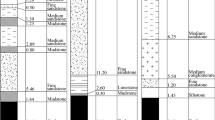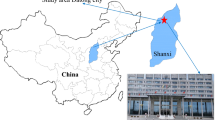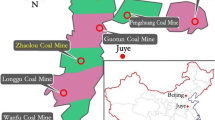Abstract
The key to safely and efficiently mining steeply inclined coal seams under water-filled strata is to size barrier pillars appropriately and to control the structural integrity of the roof. We propose a method for goaf filling and grouting of steeply inclined coal seams and for appropriately sizing barrier and sectional coal pillars for mining in such conditions. Through theoretical analysis, an expression for a reasonable barrier pillar size was derived, based on the time span of mining, the hydraulic characteristics of the coal seam, the permeability characteristic of the grout in the goaf, and the water pressure. Based on the degree of saturation of the overlying strata and the mining conditions of the steeply inclined no. 48 coal seam of the Longhu mine in Qitaihe, China, we determined through theoretical analysis that the barrier pillar should be 80 m, the width of the sectional coal pillar should be 15 m, the length of the goaf filling should be 80 m, and the grouting length should be 40 m, to ensure safe production in that mine without geotechnical failures or injuries. These recommendations are being implemented.
Zusammenfassung
Der Schlüssel zum sicheren und effizienten Abbau von steil einfallenden Kohlelagern unter wasserführendem Deckgebirge ist es, die Barrierepfeiler gewissenhaft zu dimensionieren und die strukturelle Integrität der Firste zu kontrollieren. Es wird eine Methode unter Verwendung von Versatz und Zementierung von steil einfallenden Kohleflözen mit ausreichend dimensionierten Barriere- und Zwischenpfeilern vorgestellt. Theoretische Berechnungen unter Beachtung der Abbaudauer, der hydraulischen Charakteristik des Kohleflözes, der Permeabilität des Versatzes im Abbaufeld und des Wasserdrucks führen zu einer vernünftigen Größendimensionierung von Barrierepfeilern. Am Beispiel des steil einfallenden Flözes Nr. 48 der Longhu Mine in Qitaihe (China) wurden unter Einbeziehung des Wassersättigungsgrades des überlagernden Deckgebirges und der Abbaubedingungen Dimensionierungsvorgaben abgeleitet. Die Größe der Barrierepfeiler sollte 80 m, die Breite der Zwischenpfeiler 15 m, die Länge des Versatzfeldes 80 m und die Zementationslänge 40 m betragen. Diese theoretisch berechneten Dimensionierungsvorgaben wurden im laufenden Abbaubetrieb ohne geotechnische Schwierigkeiten angewendet und führten zur Absicherung der Produktion.
Resumen
La clave para una segura y eficiente minería en vetas de carbón con inclinación abrupta bajo estratos llenos de agua, es el tamaño apropiado de los pilares de la barrera y el control de la integridad estructural del techo. Proponemos un método para el llenado de los huecos, el relleno con cemento de las vetas de carbón inclinadas abruptamente y para la determinación del tamaño apropiado para la barrera y para la sección de los pilares bajo tales condiciones. A través de análisis teórico se derivó una expresión para un tamaño razonable de los pilares de la barrera, basado en el lapso de tiempo de la minería, las características hidráulicas de la veta de carbón, las características de permeabilidad del cemento en los huecos y la presión del agua. Basados en el grado de saturación del estrato superior y las condiciones de la minería de la abruptamente inclinada veta de carbón no. 48 de la mina Longhu en Qitaihe, China, determinamos a través de análisis teóricos, que los pilares de la barrera deberían ser 80 m, el ancho de la sección del pilar debería ser 15 m, la longitud del llenado de los huecos debería ser 80 m y la longitud del llenado con cemento debería ser 40 m para asegurar una producción segura sin fallas geotécnicas o daños. Estas recomendaciones están siendo implementadas.
摘要
含水层下伏急倾斜煤层安全开采的关键是防水煤岩柱设计及有效控制顶板结构完整性。本文提出一套急倾斜煤层采空区充填及注浆方法和一套煤岩柱尺寸与煤柱截面尺寸计算方法。通过理论分析,得到一种基于回采时段变化、煤层水文特征、采空区注浆体导水性和水压等因素分析的煤岩尺寸计算公式。中国七台河龙湖煤矿48#煤层为急倾斜煤层且位于含水层之下,通过理论分析得出,防止急倾斜顶板岩石力学破坏和灾害的煤岩柱尺寸为80 m、煤柱截面宽15 m、采空区充填长度40 m。该开采设计方案已经被生产单位采纳







Similar content being viewed by others
References
Aston TRC, Singh RN, Whittaker BN (1983) The effect of test cavity geology on the in situ permeability of coal measures strata associated with longwall mining. Int J Mine Water 4:19–34
Doulati Ardejani F, Singh RN, Baafi E, Porter I (2003) A finite element model to: 1. predict groundwater inflow to surface mining excavations. Mine Water Environ 22:31–38
Du JP, Wang LQ (2005) Special mining methods of coal mines. China Univ of Mining and Technology Press, Xuzhou
Fawcett RJ, Hibberd S, Singh RN (1984) An appraisal of mathematical models to predict water inflows into underground coal workings. Int J Mine Water 2:33–54
Gale WJ (1996) Geological issues relating to coal pillar design. In: McNally GH, Ward CR (eds), Proc, Symp of Geology in Longwall Mining p 185–191
Gale WJ (1998) Coal pillar design issues in longwall mining. Proc, Coal Operators’ Conference, Univ of Wollongong and the Australasian Institute of Mining and Metallurgy, pp 133–146
Gui HR (1997) The analytical methods of retaining reasonable water barriers. China Coal Industry Publ House, Beijing
Hartman HL (1992) SME mining engineering handbook. Soc for Mining Metallurgy and Exploration, Littleton
Jia JQ, Wang HT, Hu GZ, Hu GZ, Li XH, Yuan ZG (2009) Methods of retaining water barrier and its stability analysis of steep working face. J China Coal Soc 3:315–319
Kong XY (2010) Advanced seepage mechanics. University of Science and Technology of China Press, Hefei
Lei PC (1993) Dynamics of Groundwater. China Agriculture Press, Beijing
Li YM (2012) Research on stability of overlying strata and reasonable waterproof coal pillar with backfilling mining in steep seam under water body. China Univ of Mining and Technology Press, Xuzhou
Li YM, Liu CY, Huang BX (2012) Influence of key stratum on waterproof coal pillar size in steep seam. J Min Safe Eng 2:226–231
Liu CW, Ding KX (2001) Research on critical size of water barrier in underground coal mine. J China Coal Soc 6:632–636
Liu CY, Liu YJ, Huang BX, Li YM, Li XM (2010) Instability characteristic and reasonable design of water-preventive coal-rock pillars in mining steep coal seam. J Min Safe Eng 3:330–334
Mark C (1992) Analysis of longwall pillar stability: an update. Proc. Workshop on coal pillar mechanics and design. US Dept of the Interior. IC 9315:238–249
Miao XX, Liu WQ, Chen ZQ (2004) Seepage theory in mining rock. Science Press, Beijing
Singh RN, Atkins AS (1984) Application of analytical solutions to simulate some mine inflow problems in underground coal mining. Intl J Mine Water 4:1–27
State Bureau of Coal Industry (2000) Coal pillar design and coal mining regulations under the conditions of the buildings. China Coal Industry Publ House, Beijing, China, Water and Railways
Tang DQ, Wu JW, Li YC, Hou JT (2006) The features of fault zone rock mass engineering geological mechanics and its effect on leaving fault waterproof pillar. J Chin Coal Soc 4:455–460
Tu M, Gui HR, Li MH, Li W (2004) Testing study on mining of waterproof coal pillars in thick loose bed and thick coal seam under ultrathin overlying strata. Chin J Rock Mech Eng 20:3494–3497
Wu Q, Wang MY, Wu X (2004) Investigations of ground water bursting into coal mine seam floors from fault zones. Int J Rock Mech Min 4:557–571
Xie DH, Feng T, Zhao FJ (2007) Mining situation and development trend of the steep seam in China. Sci Info 14:211–213
Xu YQ (2004) Coal mining. China Univ of Mining and Technology Press, Xuzhou
Yu XH (2009) Basis of hydrocarbon reservoir geology. Petroleum Industry Press, Beijing
Acknowledgments
Financial support for this work was provided by the NSFC program (No. 51174192), the Innovation Project of Graduate Students Training of Jiangsu Province (No. CXLX12_0964), and the “333” Training Foundation of Jiangsu Province (No. BRA2010024).
Author information
Authors and Affiliations
Corresponding author
Rights and permissions
About this article
Cite this article
Liu, C.Y., Yang, J.X. & Wu, F.F. A Proposed Method of Coal Pillar Design, Goaf Filling, and Grouting of Steeply Inclined Coal Seams Under Water-Filled Strata. Mine Water Environ 34, 87–94 (2015). https://doi.org/10.1007/s10230-014-0314-4
Received:
Accepted:
Published:
Issue Date:
DOI: https://doi.org/10.1007/s10230-014-0314-4




